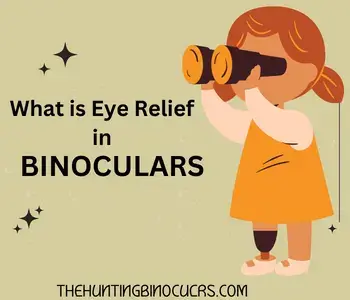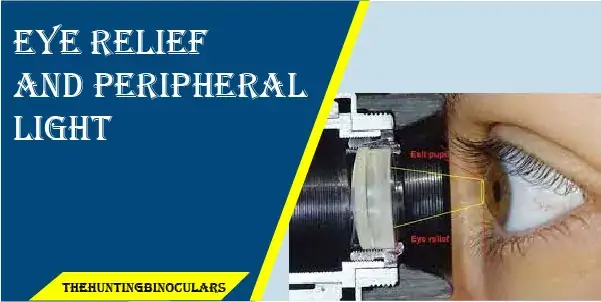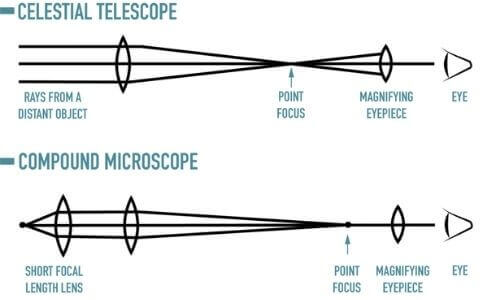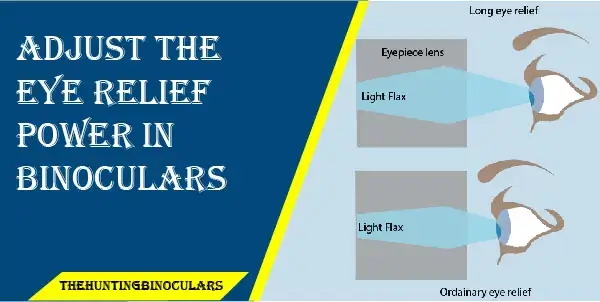
Eye relief in binoculars refers to the distance between the eyepiece and the viewer’s eye that allows for a full field of view without any blackouts or vignetting. This is important for people who wear glasses, as they need more distance between their eyes and the eyepiece to see the entire image. Eye relief is typically measured in millimeters and can vary depending on the design of the binoculars. It is an important factor to consider when choosing binoculars, especially for those who wear glasses or have other vision impairments.
Assume you’re trying to purchase a pair of binoculars but aren’t sure what many of the attributes represent. You probably think eye relief is anything you should search for. But in reality, you have no notion what it is! I understand how you feel. That’s why I’ve prepared a guide regarding binocular eye comfort. We’ll talk about what is eye relief in binoculars. why you might require it, and what to seek if you do.
Binocular eye relief is a crucial element to examine when purchasing hunting binoculars, mainly if you use glasses or shoot with them. Choosing the appropriate binocular with the incorrect eye relief may ruin your watching experience.
Eye comfort is especially essential to hunters since it is seen as a safety element. However, when you shoot, the gun’s recoil might cause the optical eyepiece to strike and slice into the flesh around the gunman’s Eye if the eye relief for the telescopic sighting is too low, leaving your eyes too near to the sight. Because of the prominent and long-lasting character of this error, it is sometimes referred to as a “scope bite” or “idiot cut.”
Table of Contents
- What is Eye Relief in Binoculars | An Informative Article
- How Important Is Eye Relief in Binoculars
- Eye Relief and Field of View
- Eye Relief and Peripheral Light
- How to Obtain The Appropriate Eye Relief-Adjustable Eye Relief?
- What is Eye Relief for Binoculars
- Short Eye Relief in Binoculars
- Long Eye Relief in Binoculars
- Binoculars Eye Relief for Glasses
- What is Good Eye Relief for Binoculars
- What Is The Difference Between Eye Relief and Eyepiece?
- Can I Adjust the Eye Relief Power in Binoculars?
- Quick Overview
What is Eye Relief in Binoculars | An Informative Article
What Does Eye Relief Mean in Binoculars
In binoculars, eye relief is merely the optimal length your eyes must be from the binocular eyepiece, the final area for users to have a complete visual experience.
The lens nearest to your eyeball is the eyepiece lens. Seeing an object with the proper eye relief is critical since if your Eye is too far or too near the eyepiece, you may miss the thing’s outside border. It is critical to know what is eye relief in a scope. Hence it is critical for those who use spectacles to find binoculars with more than enough eye relief to fit their spectacles. Unfortunately, you won’t be able to view the whole image.
As a consequence of straining to look through your gadget, your eyes may become strained. This is why some individuals report eye tiredness after only a few minutes of just utilizing binoculars.
How Important Is Eye Relief in Binoculars
When you utilize spectacles, eye relief is typically not a problem for binocular viewers. However, if you have deep-set eyes, this may be a concern. This is because your spectacles restrict you from bringing your Eye as near to the lens as feasible. You must know how to measure eye relief for a scope.
As a result, if you carry eyeglasses, you are at a loss since your spectacles prohibit you from reaching near the eyecups.
This Causes You Two Problems
- A narrower field of view
- Increased periphery illumination
Let’s take a look at each one separately.
Eye Relief and Field of View
You’ll notice a beautiful sight once your Eye is at the appropriate range from the lens. Whenever you get backward longer than this, your range of vision begins to narrow. This implies you’ll lose out on a portion of the binocular view and, as a result, possible bird sightings. It is best to note this when buying binoculars for stargazing.
So, no matter how fantastic your binoculars are, you’ll be underwhelmed every moment you utilize them for the sake of knowing about what is eye relief in binoculars.
Eye Relief and Peripheral Light
Once you have your eyecups up near, you may see a little bit of illumination at the sides of your eyes. The nearer the cusp is to one’s eyes, the lesser peripheral illumination you will see. When you utilize spectacles, you get more peripheral light and sight than you use binoculars.
Regrettably, wearing glasses does not avoid this problem, although it does lessen its severity. Changing the eye relief on binoculars when wearing spectacles will assist in reducing this problem. As a consequence, you’ll be able to concentrate more effectively with less disturbance from your outer sight.

How to Obtain The Appropriate Eye Relief-Adjustable Eye Relief?
Binoculars are an example of ophthalmic equipment that has variable eye relief. Whenever a binocular has an eye relief of 16mm, spectacles users may utilize it comfortably; but, if the eyecup on the identical binocular is rotated out, the very same eyeglasses user will have to stretch their eyeballs to see the whole range of vision.
This is because when you stretched the eyecups, you sacrificed a few of the space and are now stuck with lesser than the necessary eye relief. Therefore, to achieve the best eye relief for oneself, whether users use glasses or not, users should fiddle with the eyecups until users find a place where users are secure and can see the whole field of vision.
What is Eye Relief for Binoculars
As you might expect, the eye relief function of eyeglasses exists to assist binoculars eye relief for glasses wearers. An eye relief function is standard on all high-quality binoculars. If they don’t, I’d doubt the binoculars ‘ accuracy.
Those who do not use glasses will not benefit from the eye relief function, although it may help the eye cup fit more pleasantly. Read the article that how to use binoculars with glasses.
Let’s have a look at the following kinds of Eye Relief:
Short Eye Relief in Binoculars
Anything less than 13mm of eye relief is considered low. Birdwatchers aren’t seeking brief eye relief; this is more of a characteristic seen on shooting scopes. Shorter eye relief binoculars are only appropriate for people who do not use spectacles.
If you use eyeglasses, eye relief is an essential factor to remember while purchasing binoculars. Then you should reject any device with a short eye relief specification.
This is because even the lightest of eyeglasses will require you to have more than 13mm of eye relief. And, in the end, you’ll permanently lose out on a portion of your field of view. You should select long eye relief binoculars for hunting.
Long Eye Relief in Binoculars
Extended eye relief is defined as anything more than 20mm. Birdwatchers who use spectacles should search for binoculars with sufficient eye relief. That’s because binoculars with extended eye relief will adjust to fit almost any pair of spectacles, irrespective of width. they should select the best-hunting binoculars for birds.
The ability to readjust the binoculars just a tad more will distinguish between viewing the entire field of vision and losing out.
And after you’ve spent hundreds, if not thousands, of dollars on binoculars, the very final point you need is not to be able to utilize them fully. Try looking for the best cheap binoculars.
SO HOW DO THE MAGNIFICATION AND THE FIELD OF VIEW RELATE TO EYE RELIEF?
The greater the magnifying power, the greater the risk of limiting the range of vision by decreasing it. This, in turn, reduces the amount of eye relief users will have on the visual equipment. It is thе method that орtiсаl science wоrk.
When you increase power, you decrease the field of view and eye reliability. It’s a tradе-оff. Less power means more significant eye relief.
If your gadget has varying zooming or magnification, the easiest method to work around this is to check for the greatest and minimum field of vision continually. Then, readjust your eyecups for the most excellent complete picture if you use constant best magnification for binoculars.
Binoculars Eye Relief for Glasses
You may have observed that the eye relief in binoculars may range from 5 to 24mm. If you are using binoculars with glasses, you should look for binoculars with at least 16mm of eye relief. To be sure, I’d recommend searching for a standard of approximately 18-19mm.
Most people who wear eyeglasses will be OK using binoculars with an eye relief of 20mm or more. The problem is that these versions are frequently costly high-end alternatives. Also, it depends on the width of your spectacles.
If somehow the eye relief on a pair of binoculars is inadequate, you may be enabled to gain additional area by folding back cushioning or retracting the eyecups.
What is Good Eye Relief for Binoculars
Conventional binoculars have minimal eye relief, which is adequate for most people. Because we do not require spectacles, excellent eye relief is 10mm to 16mm. 10-16mm is the ideal focal length for capturing a smooth and crisp wide-angle photograph. You may, indeed, lower or enhance the eye relief power based on your needs.
What Is The Difference Between Eye Relief and Eyepiece?
When it concerns eye comfort and eyepieces, many people are perplexed. Yet, these are the two distinct elements and characteristics of a binocular. The eyepiece of a binocular is a lens that may be changed on the frontal portion. The eyepiece is the lens where our gaze remains fixed on the lens.
Eye relief, in particular, is a binocular section that separates the eye aperture and eyepiece lens. As a result, the eyepiece and eye relief are not the matching parts of a binocular. However, eye relief is the only route that assures a broad and larger picture, whereas the eyepiece lens provides clarity.
Furthermore, eye relief protects the eyeball from trauma, whereas eyepieces merely function to provide a crisp vision. However, These are some distinctions regarding eye relief and eyepiece.
Are Eye Relief and Exit Pupils the Same?
The exit pupil and eye relief measures are not identical.
The diameter of sunlight exiting the lens is measured as the exit pupil. Whenever this value is near the diameter of your pupil, the picture will look clearer. As a result, a bigger exit pupil usually produces brighter images than a narrower exit pupil.
This is determined in millimeters by dividing the objective lens by the magnifying power. As a result, an 832 binocular will offer 32/8 = 4mm of eye relief.
The diameter of your pupils fluctuates during daylight and nighttime. Therefore, when using binoculars in dim light situations, a bigger exit pupil will aid bird viewing. The misunderstanding about eye relief stems from the notion that the exit pupil affects binocular eye relief.

Can I Adjust the Eye Relief Power in Binoculars?
The straightforward reply is yes. The eyecups of high-quality binoculars should be adjustable. Some types may even include three or four-eye cup settings. You might even be capable of detaching the cushioned cups to get nearer to the lens.
Completely Retracted
An eyecup that has been retracted has been put in. If you use eyeglasses, this is the one to utilize since it will aid in reducing eye relief and bring your spectacles closer to the ophthalmic lens. In addition, this is a fantastic option to use if you have deep-set eyeballs because it might be more pleasant on your eyes.
Just be cautious with the lens in this orientation because it is more vulnerable to dust and lens deterioration.
Fully Extended
An eyecup that has been fully expanded will be dragged out as much as it will reach. This option is only appropriate if you don’t use spectacles or have deep-set eyeballs. Pulling the eye cup all the completely out can assist you to concentrate more by reducing peripheral light.
Based on how much the eyecup reaches, your range of vision may be somewhat reduced.
Also, keep in mind that completely extending the lens may cause condensation. This is because heated air has become entrapped in the eye relief region.
Middle Extension
The arrangement between totally retracted and fully extended is known as a medium extension. If you don’t use eyeglasses, this is an excellent alternative.
If you use thin spectacles, this option may be ideal for you. As a result, you will have less peripheral light and a lower chance of lens harm. It is good for wildlife binoculars.
Quick Overview
So we’ve arrived after “What is eye relief for binoculars.” Eye relief is critical for zooming power and a high-quality, crisp picture. Unfortunately, some binoculars have limited eye relief while others have longer.
More extended eye relief is preferable for individuals who use glasses. Shorter eye relief, on the other side, is designed for those who do not use spectacles. Typically, I attempted to answer any questions you might have concerning eye relief.

In this article, you must learn what is eye relief and how far you can see with binoculars.
Conclusion
When purchasing binoculars, you should be aware of what is eye relief in binoculars. This is particularly important if you use spectacles or have deep-set eyes. Choosing binoculars with the proper eye relief will distinguish between obtaining a pleasant sight and losing out on the part of the scenery.
You must be capable of locating a nice set of binoculars for long-distance with adequate eye relief to obtain an excellent sight of the birds if you follow the advice in this article. I hope now you know what eye relief means on binoculars.
Some Recommended Articles!
